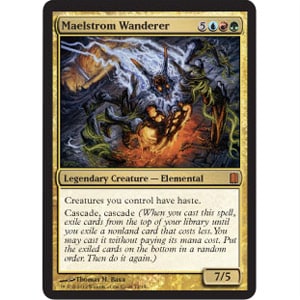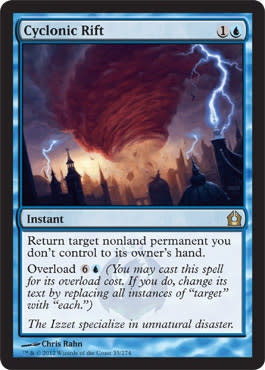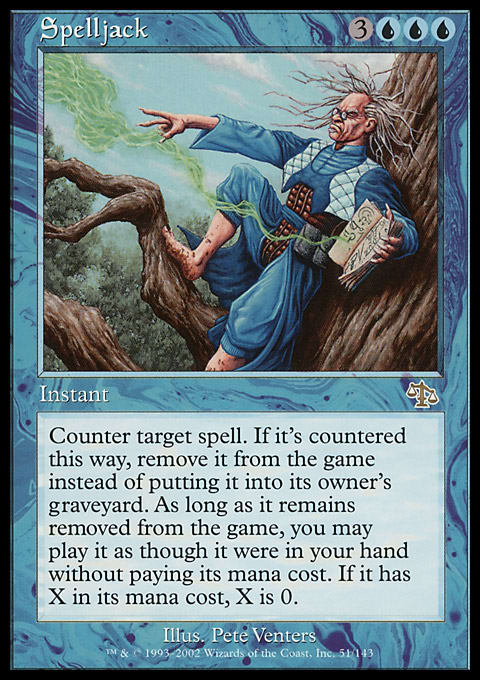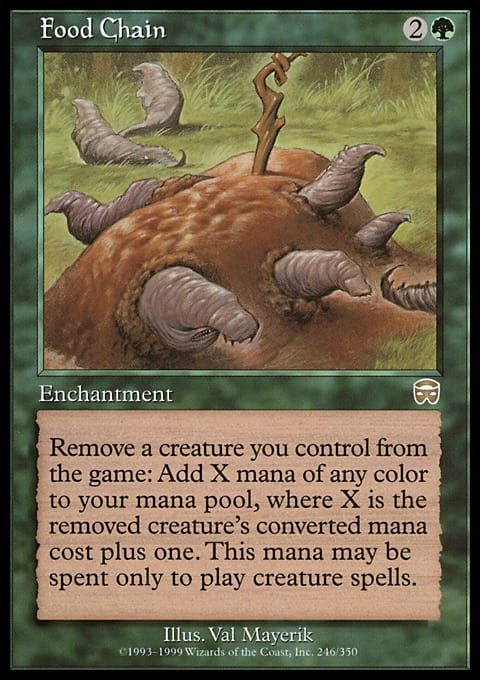Welcome back, readers. So far, this series has gotten a lot of good conversations going. No one has sent me a decklist yet, but since this concept has only had a name for a few weeks, I imagine people are still brewing. Last week, we talked about the first Commander deck I ever built, so this week, I want to talk about the second one. This is a deck that I feel goes in a very different direction, but a direction that highlights another way to build a deck that is pure 75%.
"75% Maelstrom"
- Commander (0)
- Lands (34)
- 1 Alchemist's Refuge
- 1 Exotic Orchard
- 1 Terrain Generator
- 1 Command Tower
- 1 Reliquary Tower
- 1 Temple of Abandon
- 1 Temple of Mystery
- 1 Temple of I-Can't-Wait-for-the-Izzet-One
- 1 Izzet Boilerworks
- 1 Gruul Turf
- 1 Simic Growth Chamber
- 1 Hinterland Harbor
- 1 Sulfur Falls
- 1 Rootbound Crag
- 1 Steam Vents
- 1 Breeding Pool
- 1 Stomping Ground
- 1 Yavimaya Coast
- 1 Karplusan Forest
- 1 Shivan Reef
- 5 Forest
- 4 Mountain
- 5 Island
- Rocks (16)
- 1 Mana Vault
- 1 Sol Ring
- 1 Izzet Signet
- 1 Simic Signet
- 1 Gruul Signet
- 1 Fellwar Stone
- 1 Illusionist's Bracers
- 1 Strionic Resonator
- 1 Mimic Vat
- 1 Crystal Ball
- 1 Chromatic Lantern
- 1 Cloudstone Curio
- 1 Thran Dynamo
- 1 Trading Post
- 1 Gilded Lotus
- 1 Mindslaver
- Dudes (30)
- 1 Birds of Paradise
- 1 Utopia Tree
- 1 Vedalken Mastermind
- 1 Taurean Mauler
- 1 Shardless Agent
- 1 Borderland Ranger
- 1 Somberwald Sage
- 1 Mystic Snake
- 1 Bloodbraid Elf
- 1 Solemn Simulacrum
- 1 Fathom Mage
- 1 Master Biomancer
- 1 Dominus of Fealty
- 1 Prophet of Kruphix
- 1 Acidic Slime
- 1 Progenitor Mimic
- 1 Niv-Mizzet, Dracogenius
- 1 Intet, the Dreamer
- 1 Prime Speaker Zegana
- 1 Frost Titan
- 1 Jace's Mindseeker
- 1 Etherium-Horn Sorcerer
- 1 Rubblehulk
- 1 Deadeye Navigator
- 1 Gruul Ragebeast
- 1 Diluvian Primordial
- 1 Sylvan Pri-sigh-I mean Phyrexian Ingester
- 1 Molten Primordial
- 1 Platinum Angel
- 1 Sphinx of Uthuun
- Spells (19)
- 1 Cyclonic Rift
- 1 Turn // Burn
- 1 See Beyond
- 1 Rampant Growth
- 1 Farseek
- 1 Cultivate
- 1 Rite of Replication
- 1 Harmonize
- 1 Plasm Capture
- 1 Pattern of Rebirth
- 1 Spin into Myth
- 1 Desertion
- 1 Spelljack
- 1 Aether Mutation
- 1 Tooth and Nail
- 1 Take Possession
- 1 Boundless Realms
- 1 Blatant Thievery
- 1 Recurring Insight
This deck is largely unchanged from its inception, and it predates the adoption and creation of the whole 75% philosophy. However, there are some aspects of it that informed the philosophy, and I think this is a prime example of a few concepts that can give you an entirely new angle from which to approach your own 75% deck.
Briefly, here are the two principles we decided on from the previous two decks:
- Scalable spells help tailor your cards to the power level of your opponents' decks.
- Always start weak and improve the deck—never weaken a better deck.
I think if I have any deck that borders on 80% territory, it's this one. Granted, a lot of the unfair things you can do require you remain relatively unmolested, but this deck has games in which you cascade into two big creatures, the combination of which puts the game out of reach or you have ridiculous aggro starts. So, what makes this as much a 75% deck as Mayael or Riku? It has a few scalable spells, and we know that makes for a good 75% deck. But how do we make sure the deck is a good 75% deck without weakening it?
The answer to that is we do weaken some of the cards, but in a creative way. I will explain.
I included several cards I like to play in Commander: Turn // Burn, Cyclonic Rift, Desertion, Plasm Capture, Tooth and Nail, and Rite of Replication. These are all powerful spells that are at home in most Commander decks, and when additional mana is paid for some of them, the effects become even more powerful. However, these spells are very situational in a deck in which you could cascade into them, and that makes them great 75% cards.
Cyclonic Rift is a beating in Commander. If you overload it, you're going to see a lot of angry faces across the table from you. Being unaffected by the bounce leaves you free to attack helpless opponents and pull way ahead on the board. However, you aren't always going to draw Cyclonic Rift. With ninety-nine cards in the deck, the odds of drawing it, even in a deck with powerful, blue draw spells like Recurring Insight and Prime Speaker Zegana, are somewhat remote. I tend to see a Cyclonic Rift in roughly every four or five games.
Since I usually play with four or five players, that is the 1 ÷ X games we normally like to try to win with our 75% decks. But notice I said that is how often I see it. How often I draw it is much lower than that. If you get your Maelstrom shenanigans going, you have a similar chance of cascading into it as you do drawing it, and when you cascade into Cyclonic Rift, it's not a great spell. You can't bounce your own guys for value when you replay them. You only are able to bounce one permanent. It's a bad Boomerang when you cascade into it, and therein lies another scaling factor: You can include quite powerful spells in your decks if you introduce an attenuating factor like variance.
If you overload a Cyclonic Rift once, people will talk about how powerful a spell it is as they scoop up their boards. If you overload it multiple times in a session, people will start to grow upset. My solution, though, isn't to weaken a decent deck by taking a card like Cyclonic Rift out—that violates one of the principles we talked about. Instead, I prefer to include powerful cards that can help you win against a 100% deck if you draw them but which have a tendency to “whiff” if you hit them with cascade.
Tooth and Nail is the same way. When I am playing against better decks, I tend to try to draw as many cards as I can to try and find a spell like Tooth and Nail, and when I play against more casual decks, I tend to cascade often and build up a big, durdly board state. When I noticed I was playing this way against both groups, I realized the inherent scalability of the deck. Cascading can be a bludgeon when you are playing a big, messy game, and the powerful R/U/G spells can be a scalpel when you need a specific answer for a specific threat. In this way, the deck almost plays itself to match the group you are with, making this among the best scaling decks I have ever conceived.
The best part is that not every spell you cascade into becomes worse (I prefer to think of it as “becomes more fair”). Spelljack is an excellent example of a spell that scales to the situation you are in. You can use it to hijack one of the opponents’ spells, making it one of those “fun” counterspells. But when you cascade into Spelljack, you can target the Maelstrom Wanderer on the stack and gain some value. Since you are more likely to cascade more in games in which you want your deck on the low side of the 75% mark, Spelljack does what you want: durdles a bit, gains you some value, and doesn't Spelljack a spell from a casual player. Against better decks, you cascade less, meaning a drawn Spelljack can sit in your hand, waiting until you can counter an Insurrection or a Decree of Pain. The fact that the scalable spells change in power whether or not you cascade means you can tailor the power level by virtue of playing the game the exact way you were going to play it anyway.
Something I thought about while I was writing the Mayael article but wanted to save until now is the concept that you can err on the side of powerful as long as you skew inconsistent. I played a game in which I hit a Frost Titan and a Progenitor Mimic with my first cascade and a Prime Speaker Zegana and a Deadeye Navigator with the second cascade. I absolutely pantsed everyone, drawing most of my deck with Zegananigans and ending the game at 40 life after swinging for triple digits. The complaint at the table after that was that our friend had a turn-one Sol Ring three games in a row. My plays were clearly more powerful than that Sol Ring, but since they were deemed to have been up to chance, no one complained, and everyone had fun. But the consistency of that turn-one Sol Ring (he didn't even have another play like a Signet or anything) even in a game in which he missed his next two land drops was deemed unfair. For whatever reason, people are more forgiving of big, powerful plays if they are deemed to be a rarity rather than something oppressive your deck does. A 75% deck can skew toward power a bit as long as it skews an equal degree away from consistency. The Mayael deck can put an It That Betrays into play on turn four, but it can also flip up a bunch of lands and ramp spells and gain nothing. I have had plenty of games in which a Mayael wearing Bracers turned up no creatures in the top ten cards, and those are the plays that people remember, not the time you put Pattern of Rebirth on a Yavimaya Elder to grab Blazing Archon and lock everyone down.
The group's perception of the power level (in terms of what they consider “fair” and “unfair”) of your deck is even more important than the actual power level. The act of cascading introduces an element of chance. Even if literally every single creature in your deck is a win condition in the current board state (Maelstrom Wanderer gives your dudes haste, too. What can’t he do?), your opponents will still groan, say “you got so lucky with the cascade!” and shuffle up for the next game. Not only that, the inconsistency introduced by cascading will make you trend toward winning 1 ÷ X games even if the deck is loaded for bear with powerful spells. This is very close to the original build, and while I didn't take anything out to make it weaker, I deliberately avoided adding cards like Food Chain. Food Chain is best when you cascade a lot, and those are the games in which you want to be doing unfair things like that the least.
This deck does have some powerful stuff in it. It has two cards from the list of cards Sheldon Menery said he would ban from Commander if he could. It can generate a ton of attack damage, and the fact that it gives your creatures haste means it can go off quickly. It also has some uncertainty built into it by virtue of the cascade when you want to play fair and have some fun, and it has the power to focus on its goals and make powerful things happen if you need to play tight and get the win.
So, what did we learn today? I think we can add a third principle to the list we have going, and that will help when I run out of decks I have built and start building from scratch.
- Scalable spells help tailor your cards to the power level of your opponents' decks.
- Always start weak and improve the deck—never weaken a better deck.
- You can skew toward power provided you skew away from consistency.
That last principle applies not only to deck-building but also to how you play the game. If you keep that in mind, there's no reason even a powerful deck can't be a great example of a 75% build.
Finally, I'd like to give a shout out to the Commander subreddit. The discussion generated by this series has informed it to a great deal, and since there has been some mention of others having their own 75% decks built or in the process of being built, I am looking forward to taking a look under the hood of a few decks sent to me by readers. Until next time, may you win every 1 ÷ X games, may you have fun doing it, and may your opponents have turn-one Sol Rings so often that no one even remembers how you won.



























